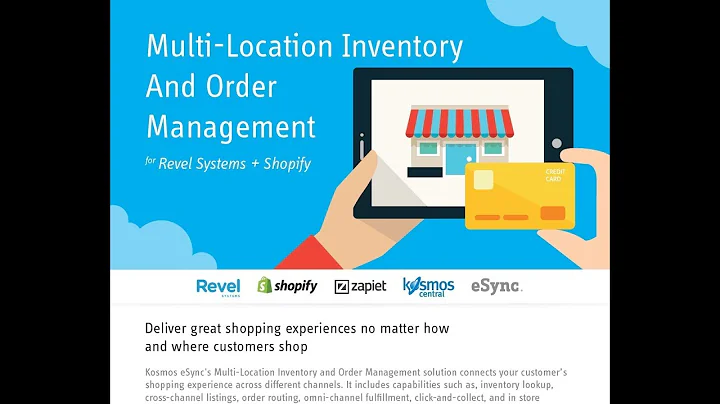Enhance Your Shopping Cart with Personalized Recommendations
Table of Contents:
- Introduction
- Building an Enhancement for the Shopping Cart Project
- Understanding the Concept of Recommendations
- Creating Additional Lists for Recommendations
- Updating the Shopping Cart with Recommended Items
- Displaying the Final Shopping Cart
- Enhancing the Display of Recommended Items
- Adding User Interaction for Purchasing Recommendations
- Implementing the Code to Append Recommended Items to the Shopping Cart
- Conclusion
Introduction
In this article, we will explore the concept of enhancements in Python programming and how it can be applied to a shopping cart project. We will delve into the process of making recommendations based on user selections, and learn how to implement this feature using Python. By the end of this article, you will have a solid understanding of how to enhance a shopping cart project and make personalized recommendations to users.
Building an Enhancement for the Shopping Cart Project
To start off, let's take a look at the shopping cart project we will be enhancing. The user is provided with the option to select one to six items for purchase. Once the user has made their selections, they can proceed to the checkout. Our goal is to add a recommendation feature that suggests additional items commonly purchased with the selected items. This will enhance the user's shopping experience and potentially increase sales.
Understanding the Concept of Recommendations
Before we dive into the implementation details, let's understand how recommendations work. We will create two additional lists, "off by two" and "off by price". These lists will be synchronized with the menu, price, and inventory lists. By associating each item in the shopping cart with the index in the "off by two" list, we can recommend other items that are commonly purchased together. The quantity of the recommended item will be determined by the quantity of the corresponding item in the shopping cart.
Creating Additional Lists for Recommendations
To implement the recommendation feature, we need to create two additional lists: "off by two" and "off by price". These lists will provide the necessary information for making recommendations. The "off by two" list will contain items that are commonly purchased with each item in the menu. The "off by price" list will store the respective prices for the recommended items. These lists will be in perfect sync with the menu list, allowing us to easily retrieve the recommended items and their prices.
Updating the Shopping Cart with Recommended Items
Once the user has finished shopping and proceeds to the checkout, we will look at the items in the shopping cart. For each item, we will determine its index in the menu list. Using this index, we can retrieve the corresponding recommended item from the "off by two" list. The quantity of the recommended item will match the quantity of the item in the shopping cart. We will then append the recommended item to the shopping cart, updating it with the additional items.
Displaying the Final Shopping Cart
After updating the shopping cart with the recommended items, we need to display the final cart to the user. For each item in the shopping cart, we will check whether it belongs to the original menu or the "off by two" list. If it is from the original menu, we will display the item's index from the menu list and retrieve its price from the "off by price" list. If it is from the "off by two" list, we will display the item's index from the "off by two" list and retrieve its price from the "off by price" list. This will ensure that all items are displayed correctly with their respective prices.
Enhancing the Display of Recommended Items
To improve the display of recommended items, we can use the strip() function to remove trailing spaces from the recommended item. This will eliminate any unnecessary spaces and make the print statement appear more aesthetically pleasing. By implementing this simple change, we can ensure that the recommended items are displayed properly without any extraneous spaces.
Adding User Interaction for Purchasing Recommendations
To provide the user with the option to purchase recommended items, we will add a question asking if they want to add the recommended item to their shopping cart. We will include the recommended item and its corresponding index in the menu. The user can enter "1" to add the item or "0" to skip it. If the user chooses to add the recommended item, we will append it to the shopping cart using the append() function.
Implementing the Code to Append Recommended Items to the Shopping Cart
To append recommended items to the shopping cart, we will iterate over each item in the shopping cart using a for loop. We will find the index of the current item in the menu list and retrieve the corresponding recommended item from the "off by two" list. If the user wants to purchase the recommended item, we will append it to the shopping cart. If the recommended item already exists in the cart, we will update its quantity based on the quantity of the corresponding item in the shopping cart.
Conclusion
In conclusion, enhancing a shopping cart project with personalized recommendations can greatly improve the user experience and potentially increase sales. By implementing the concepts discussed in this article, you will be able to add a recommendation feature to your Python project. Remember to be systematic and consider additional enhancements that can further enhance the recommendation process. Enjoy coding and have fun exploring new possibilities with Python!
Highlights:
- The Python programming course at www.wi-fi.in offers endless possibilities for project enhancements.
- Building an enhancement for a shopping cart project can greatly improve the user experience.
- Recommendations are a powerful tool for increasing sales and providing personalized shopping suggestions.
- Creating additional lists that are synchronized with the menu and price lists is crucial for making recommendations.
- Updating the shopping cart with recommended items enhances the user's shopping experience and encourages additional purchases.
- Displaying the final shopping cart with correct item prices ensures transparency for the users.
- Enhancing the display of recommended items by removing trailing spaces creates a more aesthetically pleasing output.
- Adding user interaction for purchasing recommendations gives users the option to personalize their shopping cart.
- Implementing the code to append recommended items to the shopping cart requires careful indexing and quantity management.
- By following these steps, you can successfully enhance a shopping cart project with personalized recommendations.
FAQ
Q: Can I add multiple recommended items to my shopping cart?
A: Yes, you can add multiple recommended items to your shopping cart. The quantity of the recommended items will match the quantity of the corresponding items in your cart.
Q: How are the recommended items determined?
A: The recommended items are determined based on the items in your shopping cart. We analyze the patterns of commonly purchased items and suggest additional items that are frequently bought together.
Q: Can I remove recommended items from my shopping cart?
A: Yes, you can remove recommended items from your shopping cart. Simply update the quantity of the recommended item to zero, and it will be removed from your cart.
Q: Are the recommended items updated in real-time?
A: No, the recommended items are determined based on the items you have selected so far. If you add or remove items from your cart, the recommended items will be recalculated accordingly.
Q: Can I customize the recommendations based on my preferences?
A: Currently, the recommendations are based on general patterns of commonly purchased items. However, in future enhancements, we plan to incorporate personalization based on user preferences.






















